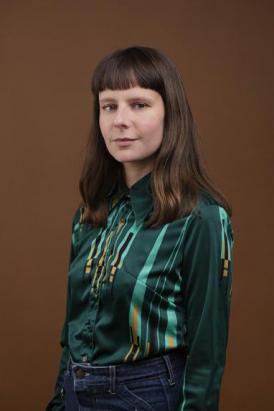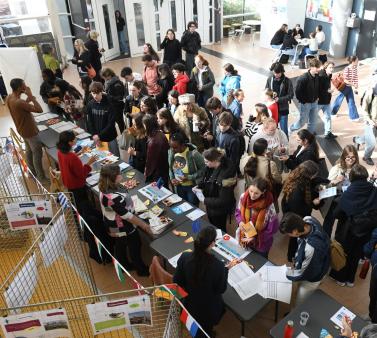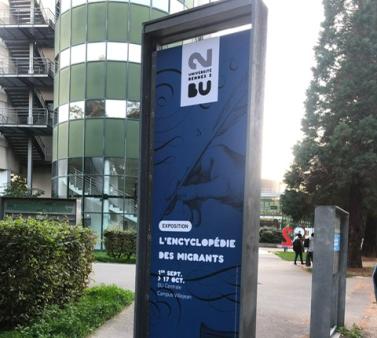
Alice Pallot © Laetitia Bica
Alice Pallot lives and works between Brussels and Paris and has exhibited in numerous European institutions and galleries. In 2022, she participated in the group exhibition .tiff at the Fotomuseum Antwerpen (FOMU- Belgium) as a prize winner. In 2023, she represented the emerging European photography in the FUTURES network, and is showing her work in a travelling group exhibition (Camera centro Italiano per la Fotografia -Italy), Copenhagen Photo Festival (Denmark), Fotofestiwal (Poland).
With Algues maudites, a sea of tears, she turns her attention to a topical issue: toxic algae. Initiated during the 1+2 Residency, her series is the result of collaboration with a number of associations and scientific bodies.
She will be present on Rennes 2's Villejean campus on Tuesday, November 14 at 1pm for an exchange on her exhibition, then in the evening after the Algues Vertes comic-book concert for a round-table discussion with Inès Léraud and François Joncour.
The Algues maudites, a sea of tears series was created in two stages: first you collaborated with the Sauvegarde du Trégor Goëlo Penthièvre association in Brittany, then with the CNRS Occitanie Ouest in Toulouse. Can you tell us more about these different phases?
Alice Pallot (A.P.): The first part of the research took place in Brittany (Côtes-d'Armor), where I met Yves-Marie Le Lay from the environmental association Sauvegarde du Trégor Goëlo Penthièvre. Together, we went out into the field to take sand samples containing black putrefied juice from decomposing algae, which would later be observed under a microscope by the CNRS in Toulouse. With his team, he inventories the species impacted by the decomposition of the algae. According to the ecologist, the tides clean the surface, but the beaches become "sterile", there are no more shellfish, and biodiversity has disappeared. Yves Marie Le Lay emphasizes the need to raise awareness and alert public authorities and the general public. The challenge for me was to translate his studies, reports, knowledge and metaphors into my own photographic language. Visual metaphors include: "Behind the green is the black", "Black tides are the new green tides...", the "sterile" beach. My work sensitively documents the impact of green algae on the environment and biodiversity. Imbued with a science-fictional imagery, my photographs intrigue and reveal invisible issues.
The second part of the project takes place in Toulouse, in the Ecologie Fonctionnelle et Environnement laboratory, with CNRS scientist Joséphine Leflaive. I cultivate the cyanobacterial microalgae on photographic prints, such as archival images of coastlines invaded by algae, or of dead animals asphyxiated by H2S gas. I then extend the action of the toxicity of these organisms to the photographic material itself.
At the same time, with Frédéric Azémar - a scientist at CNRS Occitanie Ouest, we create an artificial aquarium saturated with algae blooms, reproducing the eutrophication phenomenon of green tides, in order to observe the change from an oxic ecosystem (life forms dependent on oxygen) to an anoxic ecosystem (not needing oxygen to live) through the process of algae decomposition.
In the film Anoxie Verte, I capture this world of hybridization and mutation. The film reveals how one ecosystem becomes extinct, giving way to a new one that we never knew existed. This immersive film opens a captivating window onto biological diversity: organisms that live without oxygen. Even if they are obviously very few in number.

Plage stérile, Algues maudites, a sea of tears © Alice Pallot, 2022
You've chosen to focus on toxic algae and their impact on biodiversity and ecosystems. How did you become aware of this issue? Why did you take up this subject?
A. P.: In November 2020, I came across an old box of spirulina supplements. My uncle, who worked in a spirulina production company, used to send them to my family on a regular basis. I ate them all my childhood, but I didn't really like them. When I came across this box again, I wanted to find out more. I spoke about it to an artist friend, Marguerite Barroux, who also wanted to know more about these microalgae, which are natural shields against oxidation.
She suggested I volunteer at a seaweed farm in Brittany to learn how to grow spirulina. I read that spirulina is a cyanobacterium that grows extremely fast, that it's one of the oldest forms of life on earth and I came across an article talking about the proliferation of green algae, its toxicity due to intensive agriculture. Being fascinated by natural phenomena and hidden realities, I wanted to find out more. I bought the comic book by Ines Léraud and Pierre Van Hove; Algues vertes, l'histoire interdite. I discovered a shocking investigation into the proliferation of green algae in Brittany. There isn't much documentation or photographic evidence on the subject, so I decided to go and see for myself what was going on. I met Yves-Marie Le Lay, who told me a lot more, particularly about the collapse of biodiversity, and that was the beginning of it!
Through your sensitive documentary photography, you aim to shed light on hidden and invisible realities. Can you tell us a little more about it?
A. P.: For this project, I'd call it an anticipatory documentary, integrating the notion of anticipation into the photographic medium by capturing a natural phenomenon: the reality of anoxic environments, in which we couldn't survive as human beings, and imbuing them with a science-fiction imaginary. In effect, I capture the invisible by making algae grow on prints, materializing a toxicity that is not visible to the naked eye, and shedding light on a subject that is shrouded in omerta. By playing on the elements of uncertainty that accompany the anticipation of a near future, I give viewers the keys to understanding the essential question of preserving ecosystems in the face of exploitation and the imminent decline of biodiversity.
Organized by Rennes 2 every two years, this cycle of events is dedicated to our relationship with nature, ecology and sustainable development. Through a series of workshops, meetings, exhibitions and shows, it invites us to reflect on environmental issues and work together to create a sustainable and desirable future!
GLAZFESTIVAL #1 - An international meeting on photography in Rennes, Brittany
The first edition will be held from November 16 to January 7, 2024 in Rennes and throughout Brittany, on the theme of "EMERGENCY". More information on glaz-festival.comThe first edition will be held from November 16 to January 7, 2024 in Rennes and throughout Brittany, on the theme of "EMERGENCY". More information on glaz-festival.com



